British Playing Sets
1750-1900 - a brief overview
These wonderful sets were made not as decorative objects, but with which to play
games of chess. They are called playing sets. The most expensive are made from
African ivory, and cheaper ones from bone, usually cow bone, and wood. Ivory
has a fine smooth surface, which is translucent and can show cross-hatched lines.
The pieces are generally white and stained red with cochineal. In the 18th century,
black was more common than red. Bone sets have speckles and lines from the small
veins and capillaries for blood flow, and are also usually white and red. The wood sets
are usually black ebony and shellacked boxwood, often patinated to beautiful
toffee-coloured shades. Rosewood and unvarnished boxwood are also found.
St George sets have their own pages.
The first set is white and black-stained ivory and dates from 1790-1840. It is identical
to one reported to be owned by Captain Cook in the 1770s, and is in the National Maritime
Museum, but there is no real evidence for Captain Cook's ownership.

Captain Cook style set. The knights were carved in Fleet Street, the chess piece carving centre

Common bone English Playing Set
The bone set is a typical cheap old English set. They are very common,
but often made up from several different sets. A "superior" version follows.

W. Howard was one of the few manufacturers to sign boxes.
This is his characteristic label, for his "superior" product.

The knights are more finely carved than in the cheaper set above, and
the eyes have a black pupil, as used in the more expensive ivory sets.
The finer carving is seen below, with the Howard knights on the left.
Howard also used a higher quality bone, with fewer speckles and lines.

The sets above have a characteristic construction with the stems screwed into the thin bases.
Wooden sets made the same way are extremely rare. The next set is made of boxwood and
rosewood. The bases are quite fragile and this set must be a rare survivor. The kings are 110 mm high.


Jaques made a wide variety styles concurrently with their Staunton sets. The Northern Upright
was a handsome set that predated the Staunton. The following has a 10.6 cm king.

It is similar to one illustrated in the Jaques Pattern Book, of which a fragment remains,
but is not a Jaques.

Jaques, along with Calvert and Lund, used shallow domed bases. They are more
elegant than the later deep domes.